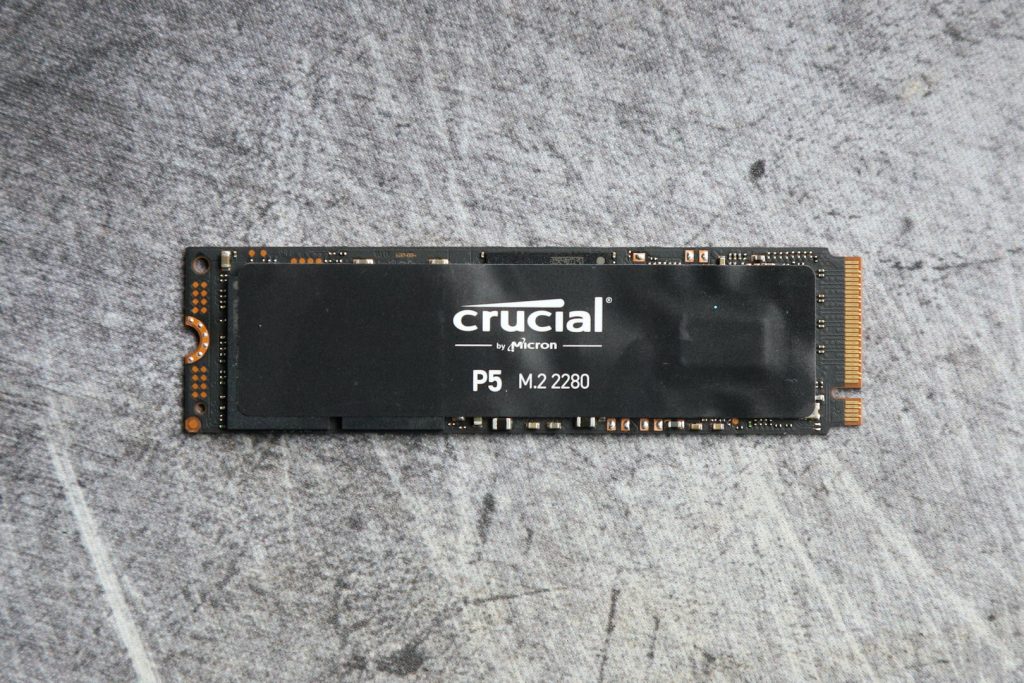Even four years after its market launch, the MX500 is still a recommendation for the SATA port. As the manufacturer's fastest NVMe SSD, the Crucial P5 cannot keep up with that. In the test, it delivers a line pattern that is too mixed for this. The own Micron controller is strong, but still needs optimization of the firmware.
Table of contents
- 1 Still no MX500 for the M.2 slot with NVMe
- Crucial's flagship still uses PCIe 3.0
- A dedicated controller from Crucial
- Equipment and prices at a glance
- 2 benchmarks, cache analysis and temperatures
- Test system and test methodology
- Cache analysis (SLC- Mode)
- Copy processes in Explorer
- Performance consistency in PCMark 10
- CrystalDiskMark
- Temperatures over time
- 3 Conclusion
Crucial's flagship still uses PCIe 3.0
The P5 is Crucial's fastest SSD and accordingly placed above the Crucial P1 and Crucial P2. In the same form factor M.2-2280 with 80 mm module length, the P5 also uses PCIe 3.0 x4 for, however, higher maximum transfer rates of 3,400 MB/s reading and 3,000 MB/s writing. Crucial did not use PCIe 4.0 with double speed for the P5, which was surprising in view of the previous announcement of the first PCIe 4.0 SSD from Crucial.
The competition has long been offering PCIe 4.0 and reaches a peak of 7,000 MB/s and more. Crucial cannot compete with high-end models like the Corsair MP600 Pro (test), the Samsung 980 Pro (test) or the WD Black SN850 (test). Rather, fast PCIe 3.0 SSDs such as the Samsung 970 Evo Plus (test) or the WD Black SN750 can be seen as competition on par with similar performance data. The test is intended to clarify whether this also applies outside of the manufacturer's information.
PCIe 4.0 is reported for a reader
The report of a reader in which the tool CrystalDiskInfo indicates the Crucial P5 with PCIe 4.0 x4 is curious. A read error was initially suspected, but a benchmark showed that the reader's P5 is at least a little faster than normal. What this “Crucial P5 with PCIe 4.0” is all about remains a mystery. The editors had already pointed this out to the manufacturer a month ago, but have not yet received a clarifying answer. The editors are not yet aware of any further reports from users.
-
Image 1 of 3
.
= “p text-width”>The P5 is offered with storage capacities of 250 GB, 500 GB, 1 TB or 2 TB. ComputerBase received the largest model with 2 TB from Crucial for testing. The smallest copy with 250 GB steps out of line with a maximum write rate of 1,400 MB/s. This is not uncommon, as many parallel accesses to numerous memory chips are required for high write performance, which are simply missing here.
Crucial's own controller
While Crucial SSDs for controllers from Marvell or Silicon Motion are known, the manufacturer is breaking new ground with the P5 and for the first time relies on a control unit developed in-house. The controller accordingly bears the logo of the parent company Micron, which, however, already relied on its own controller for the OEM SSD Micron 2200. Micron had already acquired the know-how in 2015 with the takeover of Tidal Systems.
-
Image 1 of 2
While Crucial is keeping a low profile on technical details and inquiries from the editorial team have recently fizzled out, the Tom & apos; s Hardware website had more information on the technology. As a result, the Micron controller of the P5 has two CPU cores of the ARM Cortex R5 type, four additional Cortex-M3 cores and one or two co-processors. Accordingly, the chip package is comparatively large at 17 × 17 mm. The architecture supports eight NAND channels and a dedicated DRAM cache.
Micron-TLC-NAND and LPDDR4
Each of the two NAND packages contains eight 1-terabit dies with Micron's 96-layer generation 3D TLC NAND. The individual DRAM chip can be identified as an LPDDR4-2133 chip with 2 GB of storage capacity, which is used for the intermediate storage of the mapping table. The back of the M.2 board has no chips.
Equipment and prices at a glance
The Crucial P5 offers optional hardware-based data encryption and is compatible with the standards AES 256 Bit, IEEE 1667, TCG Opal 2.0 and Microsoft eDrive (BitLocker). The manufacturer does not use a cooler or special foils in the sticker for better heat dissipation.
As is now common with NVMe SSDs, Crucial also offers a guarantee of up to five years for the P5. However, this only applies if the guaranteed write volume (“Total Bytes Written”, TBW) is not exceeded beforehand. The TBW is 600 TB per terabyte, which is a common value for SSDs of this class with TLC storage.
The Crucial P5 has been on the market for a while and accordingly widely available. The prices are currently (May 5, 2021) around 48 euros (250 GB), 50 euros (500 GB), 120 euros (1 TB) and 274 euros (2 TB). Due to the hardly existing surcharge of 500 GB, the purchase of the 250 GB version is currently not worthwhile.
Crucial P5 controller: Micron DM01B2, 8 NAND channel DRAM cache:? LPDDR4 memory capacity: 250/500/1,000/2,000 GB Memory chips: Micron? ? TLC (3D, 96 layers) NAND,? Form factor: M.2 (80 mm) Interface: PCIe 3.0 x4 seq. Read: 3,400 MB/s seq. Write: 1,400 MB/s Variant 3,000 MB/s 4K Random Read: 210,000 IOPS Variant 390,000 IOPS Variant 430,000 IOPS 4K Random Write : 355,000 IOPS variant 500,000 IOPS Power consumption Activity (typ.):? Power consumption activity (max.):? Power consumption idle:? Power consumption DevSleep:? Power consumption L1.2:? Functions: NVMe, NCQ, TRIM, SMART, Garbage Collection Encryption: AES 256, IEEE-1667, TCG Opal 2.0, Windows eDrive Total Bytes Written (TBW): 150 terabytes, 300 terabytes, 600 terabytes, 1,200 terabytes Guarantee: 5 years Price: from € 48/from 50 €/from 100 €/from 280 € Price per GB: € 0.19/€ 0.10/€ 0.10/€ 0.14
On the next page : Benchmarks, cache analysis and temperatures
